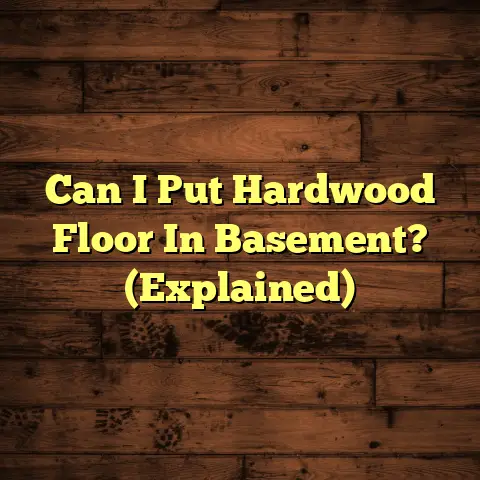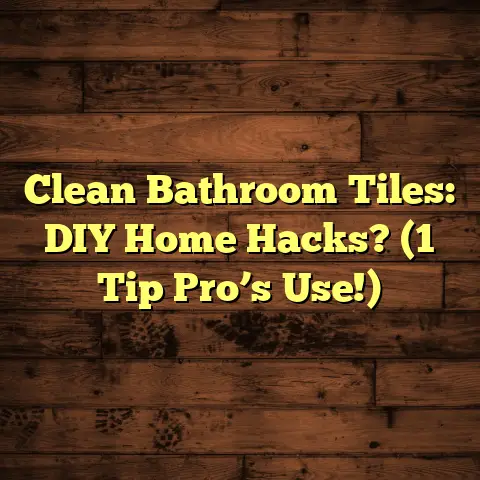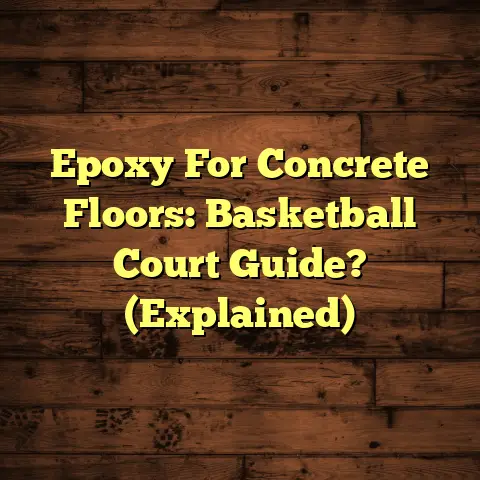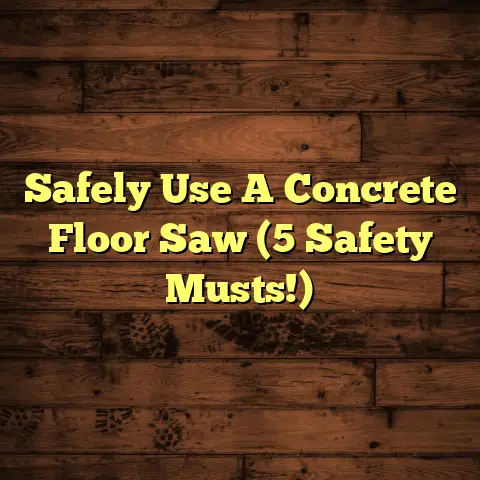Pergo Flooring Cost: Assess Now! (3 Budget Busters!)
But, we all dream of beautiful, functional homes, right? And flooring is a HUGE part of that. It’s not just about looks, though. It’s about how we live in our homes, day in and day out.
That’s where Pergo flooring comes in. It’s a popular choice for folks who want durability, style, and relatively easy upkeep. But before you jump in, let’s talk about the real deal: the cost.
Trust me, as a flooring contractor for over 15 years, I’ve seen my fair share of flooring projects go sideways due to budget surprises. Let’s make sure that doesn’t happen to you!
Section 1: Understanding Pergo Flooring
So, what exactly IS Pergo flooring? Let’s break it down.
Pergo, originally a Swedish company, essentially invented laminate flooring back in the 1970s. Today, the name “Pergo” is often used generically to refer to laminate flooring, but they also produce luxury vinyl plank (LVP) and other flooring types.
Think of laminate as layers of materials fused together. It usually has a high-density fiberboard (HDF) core, a decorative photographic layer that looks like wood, tile, or stone, and a tough, transparent wear layer on top. LVP, on the other hand, is made of 100% waterproof vinyl.
Why is Pergo so popular?
- Durability: Pergo’s wear layer is designed to withstand scratches, dents, and fading. It is perfect for active families and pets.
- Easy Installation: Many Pergo products are designed for DIY installation with click-lock systems.
- Water Resistance (and Waterproof Options): While not all Pergo is waterproof, many of their products offer excellent water resistance, and their LVP lines are fully waterproof.
- Variety: You can find Pergo in a huge range of styles, colors, and textures.
Pergo vs. Hardwood:
| Feature | Pergo (Laminate) | Hardwood |
|---|---|---|
| Cost | Lower | Higher |
| Durability | High (scratch/dent resistant) | Can scratch/dent more easily |
| Water Resistance | Moderate to High | Low (unless specially treated) |
| Installation | Easier (DIY-friendly) | More complex (usually pro) |
| Maintenance | Easier | More demanding |
| Appearance | Replicates wood/stone | Authentic wood grain |
While hardwood has a certain undeniable charm, Pergo offers a practical and cost-effective alternative for many homeowners.
Section 2: Estimating the Cost of Pergo Flooring
Alright, let’s get down to the nitty-gritty: the cost. This is where things can get tricky, so pay attention!
The cost of Pergo flooring depends on several factors:
- Material: Laminate vs. LVP, the thickness of the wear layer, and the overall quality of the product all affect the price.
- Style and Finish: More realistic wood-look textures and unique patterns will generally cost more.
- Installation: DIY vs. professional installation makes a HUGE difference.
- Location: Prices can vary depending on where you live and the availability of contractors.
Ballpark Figures:
Generally, you can expect to pay somewhere between $3 to $10 per square foot for Pergo flooring materials.
- Basic Laminate: $3 – $5 per square foot
- High-End Laminate/LVP: $5 – $10 per square foot
These are just estimates, of course. For example, Pergo TimberCraft + WetProtect Waterproof Laminate can be on the higher end, especially with professional installation.
Additional Costs to Consider:
Don’t forget these often-overlooked expenses:
- Underlayment: Most Pergo installations require underlayment for sound absorption and moisture protection. Expect to pay $0.50 to $1.50 per square foot.
- Trims and Moldings: Baseboards, quarter-round, and transition strips are necessary for a finished look. Budget around $3 to $8 per linear foot.
- Old Flooring Removal: If you’re replacing existing flooring, you’ll need to factor in the cost of removal and disposal. This can range from $1 to $3 per square foot.
- Subfloor Preparation: A level subfloor is crucial for a successful Pergo installation. If your subfloor needs repairs or leveling, that’s an extra expense.
- Tools and Supplies: If you’re doing DIY, you’ll need tools like a tapping block, pull bar, saw, and measuring tape.
Section 3: The 3 Budget Busters
Okay, now for the main event: the budget busters! These are the things that can sneak up on you and send your flooring project spiraling out of control.
Budget Buster #1: Installation Costs
This is a BIG one. I can’t stress enough how much installation can impact your overall cost.
DIY vs. Professional Installation:
- DIY Pros: Save money on labor costs.
- DIY Cons: Time-consuming, requires skills and tools, potential for errors that can lead to costly repairs.
- Professional Pros: Faster, guaranteed quality, expertise in handling unexpected issues.
- Professional Cons: Adds significantly to the overall cost.
The Hidden Costs of DIY:
Let’s say you’re quoted $4 per square foot for Pergo flooring materials. You think, “Great! I’ll just install it myself and save a ton of money!”
But then you realize:
- You need to buy or rent a flooring saw ($100 – $300).
- You don’t have a tapping block or pull bar ($20 – $50).
- You accidentally damage a few planks and need to buy replacements.
- You spend an entire weekend wrestling with the installation, only to realize you’ve made some mistakes that need to be fixed.
Suddenly, your “cheap” DIY project isn’t so cheap anymore.
The Pitfalls of Improper Installation:
I’ve seen it all:
- Gaps between planks due to uneven subfloors.
- Buckling due to improper expansion gaps.
- Water damage due to poor sealing around edges.
These issues not only look bad but can also shorten the lifespan of your flooring and lead to expensive repairs down the road.
My Advice:
If you’re comfortable with basic home improvement projects and have the time and patience, DIY can save you money. But be honest with yourself about your skills and limitations.
If you’re unsure, it’s almost always better to hire a professional installer. Get multiple quotes, check references, and make sure they’re licensed and insured.
Pro Tip: Ask your installer for a detailed breakdown of their costs, including labor, materials, and any potential extra charges.
Budget Buster #2: Maintenance and Repair
Don’t just think about the upfront cost. Consider the long-term maintenance and repair expenses.
Common Issues with Pergo Flooring:
- Scratches: While Pergo is scratch-resistant, it’s not scratch-proof. Pet claws, furniture, and dropped objects can cause scratches.
- Dents: Heavy objects can dent Pergo flooring, especially laminate.
- Water Damage: While many Pergo products are water-resistant or waterproof, standing water can still cause damage if left for extended periods.
- Fading: Prolonged exposure to direct sunlight can cause Pergo flooring to fade over time.
Repair Costs:
- Minor Scratches: Can often be repaired with a touch-up kit ($10 – $20).
- Deeper Scratches or Dents: May require professional repair or plank replacement. Expect to pay $50 – $150 per plank replaced.
- Water Damage: Can be extensive and costly to repair, especially if it affects the subfloor.
Warranty Conditions:
Read the fine print! Pergo warranties typically cover manufacturing defects but may not cover damage caused by improper installation, misuse, or accidents.
Maintenance Tips to Minimize Costs:
- Use doormats at entrances to trap dirt and debris.
- Sweep or vacuum regularly to remove abrasive particles.
- Use furniture pads under heavy objects.
- Clean spills immediately.
- Avoid using harsh chemicals or abrasive cleaners.
- Consider window coverings to protect against direct sunlight.
My Advice:
Proper maintenance is key to extending the life of your Pergo flooring and minimizing repair costs. Invest in quality cleaning products and follow the manufacturer’s recommendations.
Budget Buster #3: Underestimating the Scope of the Project
This is where a lot of homeowners get caught off guard. They focus on the cost of the flooring itself and forget about all the other things that go into a flooring project.
Commonly Overlooked Expenses:
- Old Flooring Removal: As I mentioned earlier, removing old flooring can be a significant expense, especially if it’s glued down or contains asbestos.
- Subfloor Preparation: A level, clean, and dry subfloor is essential for a successful Pergo installation. If your subfloor is uneven, damaged, or contaminated, you’ll need to repair or replace it.
- Moving Furniture: You’ll need to move all your furniture out of the room before the installation can begin. This can be time-consuming and physically demanding, or you may need to hire movers.
- Disposal Fees: You’ll need to dispose of the old flooring and any construction debris. Landfill fees can add up quickly.
- Unexpected Problems: You never know what you’ll find when you start tearing up your old flooring. There could be hidden water damage, mold, or other surprises that require additional work.
Case Study:
I once had a client who wanted to install Pergo flooring in their basement. They thought they could save money by doing the demolition themselves.
But when they removed the old carpet, they discovered extensive mold growth under the padding. They had to hire a professional mold remediation company, which added thousands of dollars to the project cost.
My Advice:
Be realistic about the scope of your flooring project. Get a professional assessment of your subfloor and factor in all the potential expenses, including demolition, disposal, and any necessary repairs.
It’s always better to overestimate your budget than to underestimate it.
Conclusion: Summarizing the Financial Impact of Pergo Flooring
Alright, we’ve covered a lot of ground. Let’s recap the key takeaways:
- Pergo flooring is a durable and stylish option that can be a great choice for busy homeowners.
- The cost of Pergo flooring depends on several factors, including material, style, installation, and location.
- The three biggest budget busters are installation costs, maintenance and repair expenses, and underestimating the scope of the project.
Key to Avoiding Financial Strain:
- Get Multiple Quotes: Compare prices from different retailers and installers.
- Read the Fine Print: Understand the warranty conditions and any limitations.
- Plan Ahead: Factor in all the potential expenses, including demolition, disposal, and subfloor preparation.
- Be Realistic: Don’t underestimate the time, effort, and skills required for DIY installation.
- Maintain Your Flooring: Proper maintenance is key to extending its life and minimizing repair costs.
Taking the time to carefully evaluate your budget and needs will ensure you make informed decisions and avoid financial surprises down the road. Good luck with your flooring project!





